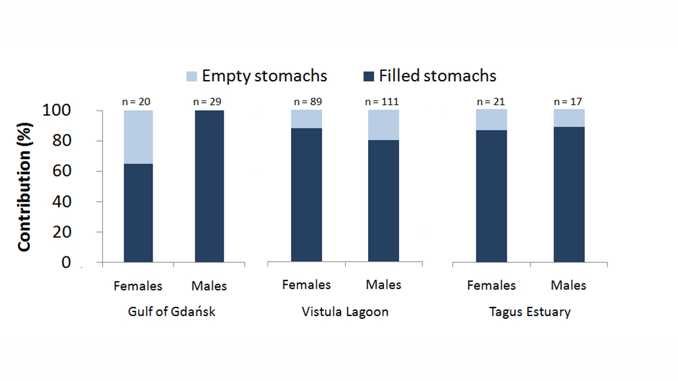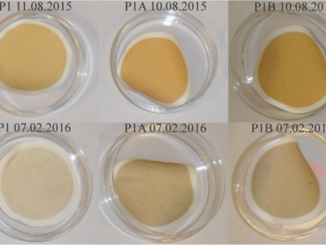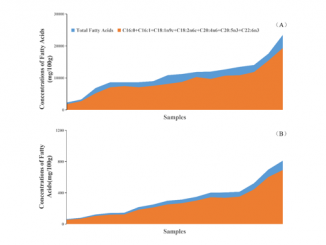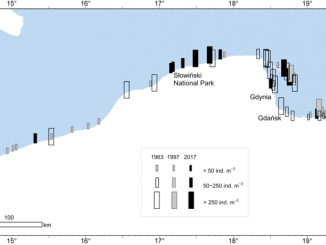
Paper category: Original research paper
Corresponding author: Dagmara J. Wójcik-Fudalewska (ocedw@ug.edu.pl)
DOI: 10.2478/ohs-2019-0021
Received: 15/01/2019
Accepted: 25/03/2019
Full text: here
Citation (APA style): J. Wójcik-Fudalewska, D., Normant-Saremba, M., Kolasa, A., et al. (2019). Diet and feeding ecology of Eriocheir sinensis on the Polish coast of the Baltic Sea and in the Tagus Estuary, Portugal. Oceanological and Hydrobiological Studies, 48(3), pp. 236-246. Retrieved 3 Oct. 2019, from doi:10.2478/ohs-2019-0021
Abstract
The feeding ecology of the Chinese mitten crab Eriocheir sinensis was studied by analyzing the stomach fullness and its content with regard to sex, size and brackish water habitats occurring on the coast of the Baltic Sea (Gulf of Gdańsk and Vistula Lagoon, Poland) and the Atlantic (Tagus Estuary, Portugal). The presented results show that neither the site, sex (except the Gulf of Gdańsk) nor the size of an individual had a significant (p > 0.05) effect on the stomach fullness of E. sinensis. However, the type of food consumed was significantly (p < 0.05) correlated with the inhabited locality. The stomachs of crabs contained the remains of animal and plant origin, as well as detritus. The remains of animals (Bivalvia, Amphipoda, Gastropoda and Polychaeta) were more frequently found in the crabs from the Gulf of Gdańsk, while the remains of plants (Tracheophyta, Chlorophyta) were most often found in the stomachs of crabs from the Vistula Lagoon and the Tagus Estuary. Detritus was found only in the Gulf of Gdańsk and the Vistula Lagoon. Research indicates that the feeding ecology of omnivore E. sinensis is habitat specific, which should be taken into account when assessing the risk associated with this invasive species.
References
Aarnio, K., Törnroos, A., Björklund, C. & Bonsdorff, E. (2015). Food web positioning of a recent coloniser: the North American Harris mud crab Rhithropanopeus harrisii (Gould, 1841) in the northern Baltic Sea. Aq. Inv. 10(4): 399–413. DOI: 10.3391/ai.2015.10.4.04.
Anastácio, P., Marques, M., Águas, M., Wójcik-Fudalewska, D. & Normant-Saremba, M. (2018). Population structure and reproductive status of the invasive Eriocheir sinensis (Decapoda, Varunidae) in the Tagus estuary (Portugal). Limnetica 37(1): 47–59. DOI: 10.23818/limn.37.05.
Anger, K. (1991). Effects of temperature and salinity on the larval development of the Chinese mitten crab Eriocheir sinensis (Decapoda: Grapsidae). Mar. Ecol. Prog. S. 72(1): 103–110. DOI: 10.3354/meps072103.
Banha, F. & Anastácio, P. (2011). Interactions between invasive crayfish and native river shrimp. Knowl. Manag. Aqua. Ecosyst. 401: 1–12. DOI: 10.1051/kmae/2011033.
Barki, A., Karplus, I., Khalaila, I., Manor, R. & Sagi, A. (2003). Male-like behavioral patterns and physiological alterations induced by androgenic gland implantation in female crayfish. J. Exp. Biol. 206 (11): 1791–1797. DOI: 10.1242/jeb.00335.
Barnes, R. (1994). The brackish-water fauna of northwestern Europe. An identification guide to brackish-water habitats, ecology and macrofauna for field workers, naturalists and students. Cambridge: Cambridge University Press.
Bridges, C. & Brand, A. (1980). The effect of hypoxia on oxygen consumption and blood lactate levels of some marine Crustacea. Comp. Biochem. Phys. A 65(4): 399–409. DOI: 10.1016/0300-9629(80)90051-1.
Cabral, H. & Costa, M. (1999). On the occurrence of the Chinese mitten crab, Eriocheir sinensis, in Portugal (Decapoda, Brachyura). Crust. 72(1): 55–58.
Cannicci, S., Dahdouh-Guebas, F., Dyane, A. & Vannini, M. (1996). Natural diet and feeding habits of Thalamita crenata (Decapoda: Portunidae). J. Crust. Biol. 16(4): 678–683. DOI: 10.2307/1549188.
Ceccaldi, H. (1989). Anatomy and physiology of digestive tract of Crustaceans Decapods reared in aquaculture. Advances in tropical aquaculture 26: 243–259.
Cristo, M. & Cartes, J. (1998). A comparative study of the feeding ecology of Nephrops norvegicus (L.), (Decapoda: Nephropidae) in the bathyal Mediterranean and the adjacent Atlantic. Sci. Mar. 62(1): 81–90.
Czerniejewski, P. & Wawrzyniak, W. (2006). Body weight, condition and carapace width and length in the Chinese mitten crab (Eriocheir sinensis H. Milne-Edward, 1853) collected from the Szczecin Lagoon (NW Poland) in spring and autumn 2001. Oceanologia 48: 275–285.
Czerniejewski, P., Rybczyk, A. & Wawrzyniak, W. (2010). Diet of the Chinese mitten crab, Eriocheir sinensis H. Milne Edwards, 1853, and potential effect of the crab on the aquatic community in the river Odra/Odra estuary (N.-W. Poland). Crust. 83(2): 195–205.
Dias, A. & Marques, J. (1999). Tagus Estuary. Value and a little bit of history. Alcochete: Instituto da Conservação da Natureza (In Portuguese).
Dias, J., Valentim, J. & Sousa, M. (2013). A Numerical Study of Local Variations in Tidal Regime of Tagus Estuary, Portugal. PLoS ONE 8(12): 1–15. DOI: 10.1371/journal.pone.0080450.
Dittel, A. & Epifanio, C. (2009). Invasion biology of the Chinese mitten crab Eriocheir sinensis: A brief review. J. Exp. Mar. Biol. Ecol. 374: 79–92. DOI: 10.1016/j.jembe.2009.04.012.
Elwood, R. (2012). Evidence for pain in decapod crustaceans. Anim. Welfare 21(S2): 23–27. DOI: 10.7120/096272812X13353700593365.
European Commission (2016). Commission implementing Regulation (EU) 2016/1141 of 13 July 2016 adopting a list of invasive alien species of Union concern pursuant to Regulation (EU) No 1143/2014 of the European Parliament and of the Council. Official Journal of the European Union L189: 4–8.
Ferreira, J., Simas, T., Nobre, A., Silva, M., Schifferegger, K. et al. (2003). Identification of sensitive areas and vulnerable zones in transitional and coastal Portuguese systems. Portugal: Institute of Marine Research.
Fladung, E. (2000). Investigations regarding regulation and utilization of the Chinese mitten crab (Eriocheir sinensis) with special regard to the fishery in the Elbe / Havel area. Potsdam-Sacrow: Schriften des Instituts für Binnenfischereie (In German).
Freire, J. (1996). Feeding ecology of Liocarcinus depurator (Decapoda: Portunidae) in the Ria de Arousa (Galicia, north-west Spain): Effects of habitat, season and life history. Mar. Biol. 126(2): 297–311. DOI: 10.1007/BF00347454.
Goñi, R., Quetglas, A. & Reñones, O. (2001). Diet of the spiny lobster Palinurus elephas (Decapoda: Palinuridea) from the Columbretes Islands Marine Reserve (north-western Mediterranean). J. Mar. Biol. Assoc. UK 81(2): 347–348. DOI: 10.1017/S0025315401003861.
Griffen, B., Altman, I., Bess, B., Hirley, J. & Penfield, A. (2012). The role of foraging in the success of invasive Asian shore crabs in New England. Biol. Inv. 15: 1877–1885. DOI: 10.1007/s10530-012-0251-8.
Halat, K. (1997). The distribution and abundance of the Chinese mitten crab (Eriocheir sinensis) in southern San Francisco Bay, 1995–1996. Unpublished M.S. thesis, University of California, Berkeley, USA.
Halat, K. & Resh, V. (1996). The Chinese mitten crab (Eriocheir sinensis): Implications for the freshwater habitats of the San Francisco Bay and Delta Ecosystem. In Sixth International Zebra Mussel and Other Aquatic Nuisance Species Conference, March 1996. Dearborn Michigan.
Hayward, P. & Ryland, J. (1995). Handbook of the marine fauna of North-
West Europe. Oxford: Oxford University Press.
Hegele-Drywa, J. & Normant, M. (2009). Feeding ecology of the American crab Rhithropanopeus harrisi (Crustacea, Decapoda) in the coastal waters of the Baltic Sea. Oceanologia 51(3): 361–375. DOI: 10.5697/oc.51-3.361.
Herborg, L., Rushton, S., Clare, A. & Bentley, M. (2003). Spread of the Chinese mitten crab (Eriocheir sinensis H. Milne Edwards) in Continental Europe: analysis of a historical data set. Hydrobiologia 503: 21–28. DOI: 10.1023/B:HYDR.0000008483.63314.3c.
Hodgkin, E. & Lenanton, R. (1981). Estuaries and Coastal Lagoons of South Western Australia. In B.J. Neilson & L.E. Cronin (Eds.), Estuaries and Nutrients (pp. 307–321). Humana Press.
Jin, G. & Xie, P. (2001). The growth patterns of juvenile and precocious Chinese mitten crabs, Eriocheir sinensis (Decapoda, Grapsidae), stocked in freshwater lakes of China. Crust. 74(3): 261–273. DOI: 10.1163/156854001505505.
Jin, G., Xie, P. & Li, Z. (2003). Food habits of two-year-old Chinese mitten crab (Eriocheir sinensis) stocked in Lake Bao’an, China. J. Fresh. Ecol. 18(3): 369–375. DOI: 10.1080/-2705060.2003.9663972.
Kidawa, A., Markowska, M. & Rakusa-Suszczewski, S. (2004). Chemosensory behaviour in the mud crab Rhithropanopeus harrisi tridentatus from Martwa Wisła Estuary (Gdańsk Bay, Baltic Sea). Crust. 77(8): 897–908. DOI: 10.1163/1568540042781711.
Klekowski, R. & Fischer, Z. (1993). Ecological bioenergetics of cold-blooded animals. Warszawa: Polish Academy of Science (In Polish).
Kneib, R. & Weeks, C. (1990). Intertidal distribution and feeding habits of the Mud Crab, Eurytium limosum. Estuaries 13(4): 462–466. DOI: 10.2307/1351790.
Kobayashi, S. (2009). Dietary preferences of the Japanese mitten crab Eriocheir japonica in a river and adjacent seacoast in north Kyushu, Japan. Plank. Benth. Res. 4(2): 77–87. DOI: 10.3800/pbr.4.77.
Kruk-Dowgialło, L. & Szaniawska, A. (2008). Gulf of Gdańsk and Puck Bay. In Ecology of Baltic Coastal Waters (pp. 139–165). Springer, Berlin, Heidelberg.
Kruk, M., Rychter, A. & Mróz, M. (Eds.) (2011). Vistula Lagoon. Natural environment and modern research methods on the example of the Visla project. Elbląg: PWSZ. (In Polish).
Lowe, S., Browne, M., Boudjelas, S. & De Poorter, M. (2000). 100 of the world's worst invasive alien species: a selection from the global invasive species database (Vol. 12). Auckland: Invasive Species Specialist Group.
Łapucki, T., Normant, M., Feike, M., Graf, G. & Szaniawska, A. (2005). Comparative studies on the metabolic rate of the isopod Idotea chelipes (Pallas) inhabiting different regions of the Baltic Sea. Thermochimica acta 435(1): 6–10. DOI: 10.1016/j.tca/2005/04/013.
Mantelatto, F. & Christofoletii, R. (2001). Natural feeding activity of the crab Callinectes ornatus (Portunidae) in Ubatuba Bay (São Paulo, Brazil): influence of season, sex, size and molt stage. Mar. Biol. 138: 585–594. DOI: 10.1007/s002270000474.
McGaw, I. & Curtis, D. (2013). A review of gastric processing in decapods crustaceans. J Comp. Physiol. B 183: 443–465. DOI: 10.1007/s00360-012-0730-3.
Nordhaus, I. (2004). Feeding ecology of the semi-terrestrial crab Ucides cordatus cordatus (Decapoda: Brachyura) in a mangrove forest in northern Brazil. Zentrum für Marine Tropenökologie.
Norman, C. & Jones, M. (1992). Influence of depth, season and moult stage on the diet of the velvet swimming crab Necora puber (Brachyura, Portunidae). Estuar. Coast. Shelf Sci. 34(1): 71–83. DOI: 10.1016/S0272-7714(05)80127-1.
O’Brien, C. (1994). Ontogenetic changes in the diet of juvenile brown tiger prawns Penaeus esculentus. Mar. Ecol. Prog. Ser. 112: 195–200. DOI: 10.3354/meps112195.
Panning, A. (1938). The Chinese mitten crab. Report of the Board of Regents of the Smithsonian Institution (Washington) 3508: 361–375.
Parslow-Williams, P., Goodheir, C., Atkinson, R. & Taylor, A. (2002). Feeding energetics of the Norway lobster Nephrophs norvegicus in the Firth of Clyde, Scotland. Ophelia 56(2): 101–120. DOI: 10.1080/00785236.2002.10409493.
Peters, N. & Panning, A. (1933). The Chinese mitten Crab (Eriocheir sinensis Milne-Edwards) in Germany. Zool. Anz. 104 (In German).
Pliński, M. (1980). Algae of the Gulf of Gdańsk: the guide to determining species. Poland: University of Gdańsk (In Polish).
Rudnick, D., Halat, K. & Resh, V. (2000). Distribution, ecology and potential impacts of the Chinese mitten crab (Eriocheir sinensis) in San Francisco Bay. Berkeley: University of California, Water Resources Center.
Rudnick, D. & Resh, V. (2005). Stable isotopes, mesocosms and gut content analysis demonstrate trophic differences in two invasive decapod crustacea. Fresh. Biol. 50(8): 1323–1336. DOI: 10.1111/j.1365-2427.2005.01398.x.
Rogers, L. (2000). The Feeding Ecology of the Invasive Chinese Mitten Crab, Eriocheir sinensis: Implications for California’s Freshwater Communities. Berkeley: University of California, Senior Research Seminar, Environmental Science Group Major.
Romero, M., Lovrich, G., Tapella, F. & Thatje, S. (2004). Feeding ecology of the crab Munida subrugosa (Decapoda: Anomura: Galatheidae) in the Beagle Channel, Argentina. J. Mar. Biol. Ass. UK 84(2): 359–365. DOI: 10.1017/S0025315404009282h.
Rychter, A., Witak, M. & Solanowska-Ratajczak, E. (2018). Fitobenthos from the Vistula Lagoon. In J. Bolałek (Eds.), The Vistula Lagoon (pp. 1–486). Poland: PWN (In Polish).
Samson, S., Yokota, M., Strüssmann, C. & Watanabe, S. (2007). Natural diet of grapsoid crab Plagusia dentipes de Haan (Decapoda: Brachyura: Plagusiidae) in Tateyama Bay. Japan. Fish. Sci. 73(1): 171–177. DOI: 10.1111/j.1444-2906.2007.01315.x.
Schäferna, K. (1935). About the Chinese mitten crab. Rybárský Vestník 15(8): 117–121.
Schmidt-Nielsen, K. (1997). Animal physiology: Adaptation and environment. Warszawa: PWN (In Polish).
Soes, D., van Horssen, P., Bouma, S. & Collembon, M. (2007). Chinese mitten crab. A Literature Study about Ecology Effects. Bureau Waardenburg (07–234).
Spooner, E., Coleman, R. & Attrill, M. (2007). Sex differences in body morphology and multitrophic interactions involving the foraging behaviour of the crab Carcinus maenas. Mar. Ecol. 28: 394–403. DOI: 10.1111/j/1439-0485.2007.00186.x.
Takahashi, K. & Kawaguchi, K. (2001). Nocturnal occurrence of the swimming crab Ovalipes punctatus in the swash zone of sandy beach in northeastern Japan. Fish. Bull. 99(3): 510–515.
Takeuchi, T. & Murakami, K. (2007). Crustacean nutrition and larval feed, with emphasis on Japanese spiny lobster, Panulirus japonicas. Bulletin of Fisheries Research Agency 20: 15–23.
Thiel, H. (1938). The general nutrition basics of Chinese mitten crab (Eriocheir sinensis Milne-Edwards) in Germany, especially in the non-native area. Zool. Mus. Inst. 47: 50–64. DOI: 10.1163/001121609X1347509202.
Turra, A. & Denadai, M. (2003). Daily activity of four tropical intertidal hermit crabs from southeastern Brazil. Braz. J. Biol. 63(3): 537–544. DOI: 10.1590/S1519-69842003000300020.
Veilleux, E. & de Lafontaine, Y. (2007). Biological synopsis of the Chinese mitten crab (Eriocheir sinensis). Can. Manusc. Rep. Fish. Aquat. Sci. 2812: vi + 45p.
Veldhuizen, T. (2001). Life history, distribution, and impacts of the Chinese mitten crab, Eriocheir sinensis. Aquatic Invaders 12(2): 1–9.
Veldhuizen, T. & Stanish, S. (1999). Overview of the life history, distribution, abundance, and impacts of the Chinese mitten crab, Eriocheir sinensis. Sacramento: California Department of Water Resources.
Webster, J., Clark, P. & Morritt, D. (2015). Laboratory based feeding behaviour of the Chinese mitten crab, Eriocheir sinensis (Crustacea: Decapoda: Brachyura: Varunidae): fish egg consumption. Aquat. Inv. 10(3): 313–326. DOI: 10.3391/ai.2015.10.3.06.
Weissburg M. & Zimmer-Faust, R. (1993). Life and death in moving fluids: hydrodynamic effects on chemosensory – mediated predation. Ecol. 74: 1428–1443. DOI: 10.2307/1940072.
Williams, M. (1982). Natural food and feeding in the commercial sand crab Portunusb pelagicus Linnaeus, 1766 (Crustacea: Decapoda: Portunidae) in Moreton Bay, Queensland. J. Exp. Mar. Biol. Ecol. 59(2–3): 165–176. DOI: 10.1016/0022-0981(82)90113-7.
Witak, M. & Pędziński, J. (2018). Morphometry of the Vistula Lagoon. In J. Bolałek (Ed), The Vistula Lagoon (pp. 1–486). Poland: PWN (In Polish).
Wójcik, D., Wojtczak, A., Anastácio, P. & Normant, M. (2014). The highly invasive Chinese mitten crab Eriocheir sinensis in the Tagus Estuary, Portugal: morphology of the specimens 20 years after the first captures. Ann. Limnol. – Int. J. Lim. 50: 249–251. DOI: 10.1051/limn/2014019.
Wójcik, D., Normant, M., Dmochowska, B. & Fowler, A. (2015). Impact of Chinese mitten crab Eriocheir sinensis on blue mussels Mytilus edulis trossulus – laboratory studies of claw strength, handling behavior, consumption rate, and size selective predation. Oceanologia 57(2): 263–270. DOI: 10.1016/j/oceano/2015.03.003.
Wójcik-Fudalewska, D. & Normant-Saremba, M. (2016). Long-term studies on sex and size structures of the non-native crab Eriocheir sinensis from Polish coastal waters. Mar. Biol. Res. 12(4): 412–418. DOI: 10.1080/17451000/2016.1148820.
Wójcik-Fudalewska, D., Normant-Saremba, M. & Anastácio, P. (2016). Occurrence of plastic debris in the stomach of the invasive crab Eriocheir sinensis. Mar. Poll. Bull. 113(1–2): 306–311. DOI: 10.1016/j.marpolbul.2016.09.059.
Zhu, X., Cui, Y. & Guang, S. (1997). Food selection and digestibility of three natural diets for the Chinese mitten crab (Eriocheir sinensis). Acta Hydrobiol. Sin. 21: 94–96.
Żmudzinski, L. (1990). Animal world of the Baltic Sea. Atlas of macrofauna. WSiP. Warszawa. (In Polish).




Bądź pierwszy, który skomentuje ten wpis